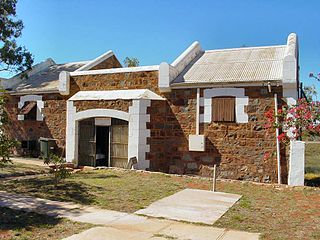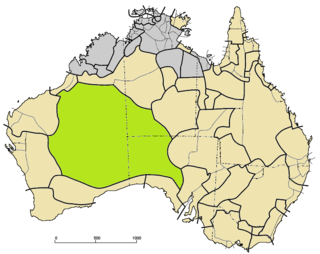Related Research Articles
The Pilbara is a large, dry, sparsely populated region in the north of Western Australia. It is known for its Aboriginal people; its ancient landscapes; the prevailing red earth; and its vast mineral deposits, in particular iron ore. It is also a global biodiversity hotspot for subterranean fauna.
Karratha is a city in the Pilbara region of Western Australia, adjoining the port of Dampier. It is located in the traditional lands and waters of the Ngarluma people, for whom it has been Ngurra (home/Country) for tens of thousands of years. It was established in 1968 to accommodate the processing and exportation workforce of the Hamersley Iron mining company and, in the 1980s, the petroleum and liquefied natural gas operations of the Woodside-operated North West Shelf Venture located on Murujuga. As of the 2021 census, Karratha had an urban population of 17,013. The city's name comes from the cattle station of the same name, which derives from a word in a local Aboriginal language meaning "good country" or "soft earth". More recently, Ngarluma people have indicated the name may actually relate to an early interpretation of "Gardarra", stemming from the sacred site for the whale, located in the Karratha area, called "Gardarrabuga". The city is the seat of government of the City of Karratha, a local government area covering the surrounding region.

Roebourne, also known by its Ngarluma name Ieramugadu, is a town in Western Australia's Pilbara region. It is 35 km from Karratha, 202 km from Port Hedland and 1,563 km from Perth, the state's capital. It is the only town on the North West Coastal Highway between Binnu and Fitzroy Crossing; over 2,000km. It is located within the City of Karratha. It prospered during its gold boom of the late 19th century and was once the largest settlement between Darwin and Perth. At the 2016 census, Roebourne and the surrounding area had a population of 981.

The Western Desert language, or Wati, is a dialect cluster of Australian Aboriginal languages in the Pama–Nyungan family.
The Kurrama people, also known as the Puutu Kunti Kurrama people, are an Aboriginal Australian people from the Pilbara region of Western Australia.
Algy Paterson was the last fluent speaker of the Martuthunira language of Western Australia.
Jurruru is an extinct Australian Aboriginal language formerly spoken in the Pilbara region of Western Australia. Its name has also been spelt Chooraroo, Choororoo, Churoro, Djuroro, Djururo, Djurruru, Dyururu, Jururu, Thuraru, Tjororo, Tjuroro, Tjururo, and Tjururu.
Yinjibarndi is a Pama–Nyungan language spoken by the Yindjibarndi people of the Pilbara region in north-western Australia.
Aboriginal Australian kinship comprises the systems of Aboriginal customary law governing social interaction relating to kinship in traditional Aboriginal cultures. It is an integral part of the culture of every Aboriginal group across Australia, and particularly important with regard to marriages between Aboriginal people.
Ngarluma and Kariyarra are members of a dialect continuum, which is a part of the Ngayarda language group of Western Australia, in the Pama–Nyungan language family. Some sources suggest that an extinct dialect, Jaburara, was a third member of the continuum. However, it is clear that Jaburara had a distinct identity that has been partly obscured by a collapse in the numbers of Jaburara speakers during the late 19th century, and there is some evidence that Jaburara may have instead been a dialect of Martuthunira.
Thalanyji and Binigura/Pinikura are two closely related languages from the Pilbara region of Western Australia. They are part of the Kanyara subgroup of the Pama–Nyungan language family.
Yinhawangka (Inawangga) is a Pama–Nyungan language of Western Australia. Dench (1995) believed there was insufficient data to enable it to be confidently classified, but Bowern & Koch (2004) include it among the Ngayarda languages without proviso.
Martu Wangka is a variety of the Western Desert language that emerged during the 20th century in Western Australia as several Indigenous communities shifted from their respective territories to form a single community.
The Ngarluma are an Indigenous Australian people of the western Pilbara area of northwest Australia. They are coastal dwellers of the area around Roebourne and Karratha, not including Millstream.
The Yindjibarndi are an Aboriginal Australian people of the Pilbara region of Western Australia. They form the majority of Aboriginal people around Roebourne. Their traditional lands lie around the Fortescue River.
The Niabali, otherwise written Nyiyaparli, are an indigenous Australia tribe of the Pilbara region of Western Australia.
The Mandara were an indigenous Australian people of the Pilbara region of Western Australia. They are extinct, having been absorbed into neighbouring peoples, and their language is unrecorded.
The Binigura people, these days usually spelt Pinikura, are an Aboriginal Australian people of the Pilbara region of Western Australia.
The Yinhawangka are an Aboriginal Australian people of the Pilbara region of Western Australia.
Juukan Gorge is a gorge in the Hamersley Range in the Pilbara region of Western Australia, about 60 kilometres (37 mi) from Tom Price. It was named by the daughter of Puutu Kunti Kurrama man Juukan, also known as Tommy Ashburton, who was born at Jukarinya.
References
- 1 2 W36 Kurrama at the Australian Indigenous Languages Database, Australian Institute of Aboriginal and Torres Strait Islander Studies
- ↑ Hill, Peter M. (2011). Morphology and Sentence Construction in Kurrama: A language of the Pilbara Region of Western Australia. University of Western Australia.